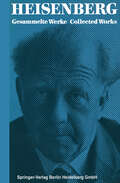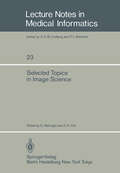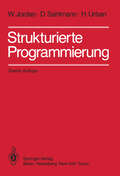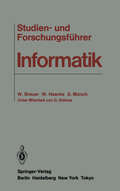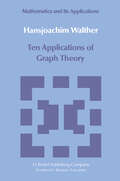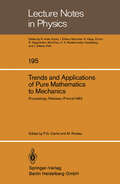- Table View
- List View
Qualitative Reasoning about Physical Systems
by Daniel G. BobrowThis volume brings together current work on qualitative reasoning. Its publication reflects the maturity of qualitative reasoning as a research area and the growing interest in problems of reasoning about physical systems.The papers present knowledge bases for a number of very different domains, including heat flow, transistors, and digital computation. A common theme of all these papers is explaining how physical systems work. An important shared criterion is that the behavioral description must be compositional, that is the description of a system's behavior must be derivable from the structure of the system.This material should be of interest to anyone concerned with automated reasoning about the real (physical) world.
Rethinking the Process of Operational Research & Systems Analysis (Frontiers of Operational FORS)
by R. Tomlinson I. KissInvited contributions from distinguished practitioners and methodologists of operational research and applied systems analysis which represent a true state-of-the-art and which provide, perhaps for the first time, a coherent, interlocking, set of ideas which may be considered the foundations of the subject as a science in its own right.
Robotics and Artificial Intelligence (NATO ASI Subseries F: #11)
by Michael Brady L. A. Gerhardt H. F. DavidsonDr. Lester A. Gerhardt Professor and Chairman Electrical, Computer, and Systems Engineering Rensselaer Polytechnic Institute Troy, New York 12180 This book is a collection of papers on the subject of Robotics and Artificial Intelligence. Most of the papers contained herein were presented as part of the program of the NATO Advanced Study Institute held in June 1983 at Castel vecchio Pascoli, Italy on the same subject. Attendance at this two week Institute was by invitation only, drawing people internationally representing industry, government and the academic community worldwide. Many of the people in attendance, as well as those presenting papers, are recognized leaders in the field. In addition to the formal paper presentations, there were several informal work shops. These included a workshop on sensing, a workshop on educational methodology in the subject area, as examples. This book is an outgrowth and direct result of that Institute and includes the papers presented as well as a few others which were stimulated by that meeting. A special note is the paper entitled "State-of-the-Art and Predictions for Artificial Intelligence and Robotics" by Dr. R. Nagel which appears in the Introduction and Overview chapter of this book. This paper was originally developed as part of a study for the United States Army performed by the National Research Council of the National Academy of Science and published as part of a report entitled "Applications of Robotics and Artificial Intelligence to Reduce Risk and Improve Effectiveness" by National Academy Press in 1983.
The Role of Technology in Distance Education (Routledge Revivals)
by Tony BatesThis book, first published in 1984, provides a comprehensive review of the range of technology that was being used in distance education. Technological developments in word processing, video-disc and viewdata as well as computer-based learning had revolutionised the potential for distance education. These developments required the role of more ‘conventional’ distance learning media, such as broadcasting, tuition and text, to be reassessed. This book, written by international experts in the field, explored the state of the art at the time, and also provided their ideas on how future developments were likely to evolve. This book is ideal for those studying education and communications.
The Role of Technology in Distance Education (Routledge Revivals)
by Tony BatesThis book, first published in 1984, provides a comprehensive review of the range of technology that was being used in distance education. Technological developments in word processing, video-disc and viewdata as well as computer-based learning had revolutionised the potential for distance education. These developments required the role of more ‘conventional’ distance learning media, such as broadcasting, tuition and text, to be reassessed. This book, written by international experts in the field, explored the state of the art at the time, and also provided their ideas on how future developments were likely to evolve. This book is ideal for those studying education and communications.
Scientific Review Papers, Talks, and Books Wissenschaftliche Übersichtsartikel, Vorträge und Bücher (Gesammelte Werke Collected Works #B)
by Dr. Walter Blum Professor Dr. Dürr Dr. Helmut RechenbergSelected Topics in Image Science (Lecture Notes in Medical Informatics #23)
by Orhan Nalcioglu and Zang-Hee ChoThe continuing growth of computed tomography (CT) and other imaging techniques motivated us to bring together a comprehensive review of the state of the art in diagnostic imaging. Twelve years after the first appearance of x-ray CT, computerized diagnostic imaging has grown so rapidly in sophistication that it is difficult to follow current developments in this diversified field. In this book, we have attempted to cover the basic developments in several areas. The first part includes some of the fundamental aspects of computerized diagnostic imaging such as algorithms and detectors. Specific applications in emission tomography, digital radiography, ultrasound and nuclear magnetic resonance imaging are dealt with in the secondpart. The contributed papers are by experts currently in the field, whom we feel would certainly enlighten the subject matter and possibly suggest directions for future development. We would like to express our sincere thanks to those who have contributed to this volume. We are sure that their original papers will be beneficial for readers and will also remain as an important reference for researchers in the years to come. We would also like to thank Betty Trent for her expert and patient typing of the entire book. Finally, special thanks are due to Mrs. Ingeborg Mayer of Springer-Verlag for her encouragements, support and patience throughout the preparation of this book.
Semiclassical Theories of Molecular Scattering (Springer Series in Chemical Physics #26)
by B. C. EuThe study of molecular collisions at energies from less than about 100 eV 3 down to a few 10- eV, which is roughly the range of chemical interest, has greatly expanded in the last 10 to 20 years. As in many fields, this activity has been stimulated by parallel advances in theory which have triggered the autocatalytic positive feedback system of experiment challenging theory and vice versa. Possibly the biggest driving force, however, has been the growing awareness that molecular collisions are important in our understanding of na tural and man-made environments. Molecular collision dynamics is now studied in connection with molecular formation in interplanetary space, upper atmo sphere chemistry, plasmas, lasers and fusion reactors, and is crucial for understanding gas-dynamic flow processes, gas-phase chemical reactions and catalysis. Despite the great strides made in studying elementary collisions in laboratory scattering experiments, many of the processes in these areas are too complicated for us to hope ever to study them in detail in the labo ratory. Thus in the long run we shall have to rely on theory. Initially, I think many of us, like myself, had hoped that the development of fast compu ters would outpace the demands on computing time so that "brute force" quan tum-mechanical exact calculations would provide all the answers. Unfortunate ly this has not been the case and efficient approximations are needed. They can be broadly classified as classical, semiclassical or semiquantal.
Simulation and Model-Based Methodologies: An Integrative View (NATO ASI Subseries F: #10)
by Tuncer I. Ören B. P. Zeigler M. S. ElzasNATO Advanced Institute Ottawa, Ontario/ Canada, July 26 - August 6, 1982
Simulation des dynamischen Verhaltens elektrohydraulischer Schaltungen: Einsatz von geräteorientierten, universellen Simulationsbausteinen (ISW Forschung und Praxis #50)
by Wolfgang RungeSimulationstechnik: 2. Symposium Simulationstechnik Wien, 25.–27. September 1984 Proceedings (Informatik-Fachberichte #85)
by F. Breitenecker W. KleinertSoftware-Engineering: Mit 77 Bildern und 22 Übungsaufgaben
by Ekbert HeringDie Kosten zur Erstellung von Software steigen im Vergleich zu den Hardwarekosten ständig. Um die wachsenden Anwenderansprüche zu befriedigen und mit dem rapiden technischen Fortschritt im Hardwarebereich Schritt halten zu können, wurde eine eigene Ingenieurdisziplin "Software-Engineering" notwendig. Das ingenieurmäßige Vorgehen soll sicherstellen, daß die Software-Herstellung termingerecht, kostengünstig, rationell und qualitätsbewußt geschieht. Software-Engineering ist ein ganz junges Gebiet der Informationswissenschaft. Deshalb sind die meisten Werke über diesen Bereich von der wissenschaftlichen Diskussion geprägt und im Anspruchsniveau relativ hoch. Für viele in der Programmierpraxis stehende Per sonen fehlt ein Lehrbuch einfacheren Charakters, das die Methoden und Hilfsmittel für die besonders wichtigen und kostenintensiven Phasen Entwurf und Test beschreibt. ln diese Lücke möchte dieses Buch stoßen. Aus der Fülle der in der Literatur vorgeschlagenen Methoden wurden diejenigen ausge wählt, die einerseits auf Grund ihrer systematischen Vorgehensweise besonders effizient sind und die andererseits wegen ihrer leichten Lernbarkeit und Einsetzbarkeit in der Praxis am häufigsten und erfolgreichsten Anwendung finden. Aus Gründen der Klarheit wurde auf eine eingehende Problematisierung der vorgestellten Methoden verzichtet. Der an einer kritischen Hinterfragung interessierte Leser sei auf das ausführliche Literaturver zeichnis verwiesen.
Software-Fehlertoleranz und -Zuverlässigkeit (Informatik-Fachberichte #83)
by F. Belli S. Pfleger M. Seifert1m vorliegenden Bericht tiber Software-Fehlertoleranz und -Zuverlassigkeit wird ein Problemkreis aus dem weitgefacherten Themenkomplex der Fehlertoleranz in Rechensystemen aufgegriffen, der in den letzten Jahren zunehmend an Bedeutung und Interesse gewonnen hat. Wahrend in der Vergangenheit ein Schwerpunkt der Fehlertoleranz-Konzepte und -Realisierungen darin lag, die Zuverlassigkeit von Rechensystemen durch MaBnahmen gegen den Ausfall von Hardware-Komponenten zu erhohen, wachst zusehends der Bedarf, auch Software in diese Bemtihungen mit einzubeziehen. Mit dem Einsatz von Rechensystemen in verschiedensten Bereichen steigen auch die Zahl und das AusmaB kritischer Anwendungen und somit die Anforderungen an die Zuverlassigkeit der eingesetzten Software. Techniken, die es gestatten, fehlerfreie, fehlertolerante und robuste Software zu erstellen, kommt daher eine neue Schltisselfunktion ftir zuklinftige Systeme zu. Bevor man jedoch spezielle Fragestellungen der Software-Fehlertoleranz und Software-Zuverlassigkeit angeht, erscheint es wichtig, den Stand der Technik in Theorie und Praxis zu erfassen und eine Bestandsaufnahme von laufenden Aktivitaten zu versuchen. Dieser Band gibt einen ersten Uberblick und will eine Basis ftir weitere Diskussionen schaffen. Er entstand im wesentlichen aus Beitragen zu einem Workshop an der Hochschule in Bremerhaven. Ziel des Workshops war der Informationsaustausch und die Diskussion zum oben erwahnten Problemkreis und zu verwandten Themen. Es nahmen 63 Fachleute aus den Bereichen Lehre, Forschung und Industrie teil.
Solid Modeling by Computers: From Theory to Applications
by Mary S. Pickett John W. BoyseThis book contains the papers presented at the international research sympo sium "Solid Modeling by Computers: From Theory to Applications," held at the General Motors Research Laboratories on September 25-27, 1983. This was the 28th syposium in aseries which the Research Laboratories began sponsor ing in 1957. Each symposium has focused on a topic that is both under active study at the Research Laboratories and is also of interest to the larger technical community. Solid modeling is still a very young research area, young even when com pared with other computer-related research fields. Ten years ago, few people recognized the importance of being able to create complete and unambiguous computer models of mechanical parts. Today there is wide recognition that computer representations of solids are aprerequisite for the automation of many engineering analyses and manufacturing applications. In September 1983, the time was ripe for a symposium on this subject. Re search had already demonstrated the efficacy of solid modeling as a tool in computer automated design and manufacturing, and there were significant re suIts wh ich could be presented at the symposium. Yet the field was still young enough that we could bring together theorists in solid modeling and practition ers applying solid modeling to other research areas in a group sm all enough to allow a stimulating exchange of ideas.
Spaß mit Algorithmen: Einführung in das strukturierte Programmieren mit 42 BASIC-Programmen
by Johann Weilharter(2) Die NEGATION Die Negation ist die Verneinung einer Aussage. Ist A die Aussage, so bezeichnet man die Negation mit --, A, A' oder A. Ist die Aussage wahr, so ist ihre Negation falsch. Ist die Aussage falsch, so ist ihre Negation wahr. A' A W F F W (3) Die UND-Zusammensetzung A B C =AAB W W W W F F F F W F F F A A B ist nur dann wahr, wenn beide Teilaussagen wahr sind. Der Fachausdruck für die UND-Zusammensetzung ist KONJUNKTION. Die Konjunktion kann auch als "logisches Produkt" erklärt werden, weil nur 1 . 1 = 1 ist, wenn man W = 1 und F = 0 setzt. (4) Die ODER-Zusammensetzung A B C=A\lB W W W W F W F W W F F F A V B ist nur dann falsch, wenn beide Teilaussagen falsch sind. Der Fachausdruck für die ODER-Zusammensetzung ist DISJUNKTION. Die Disjunktion kann auch als "logische Summe" erklärt werden, weil nur 0 + 0 = 0 ist, wenn man W = 1 und F = 0 setzt. Wichtig: Dieses ODER ist nicht ausschließend.
Stochastic Methods and Computer Techniques in Quantum Dynamics: Proceedings of the XXIII. Internationale Universitätswochen für Kernphysik 1984 der Karl-Franzens-Universität Graz at Schladming (Steiermark, Austria), February 20th - March 1st, 1984 (Few-Body Systems #26/1984)
by H. Mitter L. PittnerThis volume contains the written versions of lectures held at the "23. Internationale Universit~tswochen fUr Kernphysik" in Schladming, Austria, in February 1984. Once again the generous support of our sponsors, the Austrian Ministry of Science and Research, the Styrian Government and others, had made it possible to organize this school. The aim of the topics chosen for the meeting was to present different aspects of stochastic methods and techniques. These methods have opened up new ways to attack problems in a broad field ranging from quantum mechanics to quantum field theory. Thanks to the efforts of the lecturers it was possible to take this development into account and show relations to areas where stochastic methods have been used for a long time. Due to limited space only short manuscript versions of the many seminars presented could be included. The lecture notes were reexamined by the authors after the school and are now published in their final form. It is a pleasure to thank all the lecturers for their efforts which made it possible to speed up publication. Thanks are also due to Mrs. Neuhold for her careful typing of the notes. H. Mitter L. Pittner Acta Physica Austriaca, Suppl. XXVI, 3-52 (1984) © by Springer-Verlag 1984 STOCHASTIC PROCESSES - QUANTUM PHYSICS+ by L. STREIT Universitat Bielefeld BiBoS D-4800 Bielefeld. FR Germany I.
Strukturierte Programmierung: Einführung in die Methode und ihren praktischen Einsatz zum Selbststudium
by W. Jordan D. Sahlmann H. UrbanTen Applications of Graph Theory (Mathematics and its Applications #7)
by Hansjoachim WaltherGrowing specialization and diversification have brought a host of monographs and textbooks on increasingly specialized topics. However, the "tree" of knowledge of mathematics and related fields does not grow only by putting forth new bran ches. It also happens, quite often in fact, that branches which were thought to be completely disparate are suddenly seen to be related. Further, the kind and level of sophistication of mathematics applied in various sciences has changed drastically in recent years: measure theory is used (non-tri vially) in regional and theoretical economics; algebraic geometry interacts with physics; the Minkowsky lemma, coding theory and the structure of water meet one another in packing and covering theory; quantum fields, crystal defects and mathematical programming profit from homotopy theory; Lie algebras are relevant to filtering; and prediction and electrical engineering can use Stein spaces. And in addition to this there are such new emerging subdisciplines as "completely integrable systems", "chaos, synergetics and large-scale order", which are almost impossible to fit into the existing classification schemes. They draw upon widely different sections of mathematics. This program, Mathematics and Its Applications, is devoted to such (new) interrelations as exempla gratia: - a central concept which plays an important role in several different mathe matical and/or scientific specialized areas; - new applications of the results and ideas from one area of scientific endeavor into another; - influences which the results, problems and concepts of one field of enquiry have and have had on the development of another.
Training for Tomorrow: Educational Aspects of Computerized Automation
by J. E. Rijnsdorp Tj Plomp J. MöllerTraining for Tomorrow: Educational Aspects of Computerized Automation is a collection of papers that discusses the introduction of automated systems in all sectors of industry, business, and society. The materials in the title particularly tackle the training concerns in the implementation of automated systems. The issues addressed in the text include training in administrative automation; development of operator training as an integrated part of the specification, design, and implementation of a process control system; and training for the planning of large-scale control systems. The selection also talks about the maintenance of professionals’ training course; the feasibility of success in retraining non-EDP college graduates for EDP occupations; and the future of automation. The book will be of great interest to individuals concerned with the implication of implementing automated systems in various sectors of industry, business, and society.
Trends and Applications of Pure Mathematics to Mechanics: Invited and Contributed Papers presented at a Symposium at Ecole Polytechnique, Palaiseau, France, November 28 – December 2, 1983 (Lecture Notes in Physics #195)
by P. G. Ciarlet M. RoseauUKSC 84: Proceedings of the 1984 UKSC Conference on Computer Simulation
by D. J. Murray-SmithUKSC 84 contains the proceedings of the 1984 United Kingdom Simulation Council Conference on Computer Simulation held at the University of Bath, England. The papers describe computer simulation techniques and their applications and cover topics ranging from simulation methodology and software to the various applications of computer simulation in areas such as policy decision-making and planning, biology and medicine, and education. This book is comprised of 52 chapters divided into nine sections and begins by describing an advanced continuous-system simulation language called ESL (ESA Simulation Language), an initiative of the European Space Agency. The papers that follow explore other simulation software, such as MANIP, SYSMOD, COSMOS, Ada, SDL (Simulation Development Language), and SPIRO (Suite of Programs for the Investigation of Recondite Objects). The discussion then turns to a methodology based on artificial intelligence for the design and development of large-scale computer simulations; a formalism for specifying continuous or fixed time-step simulation models that is a straightforward extension of the block-oriented languages, with emphasis on superblocks and tesselations; and simulation of manufacturing and control systems. This book concludes with a chapter that describes a highly efficient compactor for a radar digital database. This monograph will be of interest to students and professionals working in the field of computer simulation.
Understanding the Manufacturing Process: Key to Successful Cad/cam Implementation
by Joseph Harrington Jr.This book approaches manufacturing as a basic problem of making a desired end-product from bulk raw materials. It encompasses the entire gamut of activities from product concept to maintenance of past products in the field, and everything in between.
Understanding the Manufacturing Process: Key to Successful Cad/cam Implementation
by Joseph Harrington Jr.This book approaches manufacturing as a basic problem of making a desired end-product from bulk raw materials. It encompasses the entire gamut of activities from product concept to maintenance of past products in the field, and everything in between.




